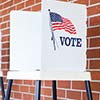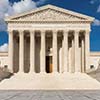Court Limits Ability to Include a Motto on School Uniforms

April 2014
Number 23
The U.S. Ninth Circuit Court of Appeals recently issued a decision regarding the limits of lawful school uniform policies under the First Amendment. In Frudden v. Pilling (9th Cir. 2014) 742 F.3d 1199, a school required students to wear a uniform, including a shirt with the motto "Tomorrow's Leaders." The school's uniform policy also contained an exception that permitted students to wear a "uniform of a nationally recognized youth organization, such as Boy Scouts or Girl Scouts, on regular meeting days" in lieu of the school uniform. The parents of two students filed a lawsuit against the school district, alleging the uniform policy violated their children's First Amendment speech rights. The district court granted the school district's motion for summary judgment, finding the students failed to state a cause of action which demonstrated their First Amendment speech rights had been violated.
On appeal, the Ninth Circuit reversed and remanded the case back to the district court, holding the First Amendment applied to the school's uniform policy because: (1) it compelled particular student speech by mandating the wearing of a shirt containing the school's motto "Tomorrow's Leaders"; and (2) the policy exemption for nationally recognized youth organization uniforms constituted a content-based regulation. Based on these two conclusions, the Ninth Circuit directed that on remand the school district must prove it has a compelling interest justifying the school's uniform policy, and that the uniform policy is narrowly tailored to serve this purpose. Although yet to be determined, it will be difficult for the school district to meet this standard when it returns to the district court.
Notably, the Ninth Circuit distinguished Jacobs v. Clark County School District (9th Cir. 2009) 525 F.3d. 419, a case the district court relied upon in dismissing student's claims. In Jacobs, the Ninth Circuit held that a school's uniform policy, which required students to wear solid colored bottoms and a solid colored polo, tee or button down shirt, did not compel speech and was therefore constitutional. In Frudden, the court found that unlike Jacobs, the school's uniform policy compelled speech because the shirts contained an expressive motto. Additionally, unlike Jacobs, the school's uniform policy was not content neutral because it contained a content-based exception, i.e., that students could wear uniforms of nationally recognized organizations on meeting days, but not for organizations that are not nationally recognized.
The Ninth Circuit's decision provides guidance regarding whether a school's uniform policy raises any First Amendment concerns and may be subject to First Amendment challenges. Under Frudden, if required school uniforms include attire containing written words or expressive mottos, then the uniform may constitute compelled speech and trigger First Amendment protection. Additionally, if a school uniform policy or its exemptions are not content neutral, the First Amendment may restrict such exemptions' implementation. With this in mind, school districts should review school uniform policies for these possible First Amendment issues.
For further information on this case or school uniform policies, please feel free to contact one of our eight offices located statewide. You can also visit our website, follow us on Facebook or Twitter, or download our Client News Brief App.
Number 23
The U.S. Ninth Circuit Court of Appeals recently issued a decision regarding the limits of lawful school uniform policies under the First Amendment. In Frudden v. Pilling (9th Cir. 2014) 742 F.3d 1199, a school required students to wear a uniform, including a shirt with the motto "Tomorrow's Leaders." The school's uniform policy also contained an exception that permitted students to wear a "uniform of a nationally recognized youth organization, such as Boy Scouts or Girl Scouts, on regular meeting days" in lieu of the school uniform. The parents of two students filed a lawsuit against the school district, alleging the uniform policy violated their children's First Amendment speech rights. The district court granted the school district's motion for summary judgment, finding the students failed to state a cause of action which demonstrated their First Amendment speech rights had been violated.
On appeal, the Ninth Circuit reversed and remanded the case back to the district court, holding the First Amendment applied to the school's uniform policy because: (1) it compelled particular student speech by mandating the wearing of a shirt containing the school's motto "Tomorrow's Leaders"; and (2) the policy exemption for nationally recognized youth organization uniforms constituted a content-based regulation. Based on these two conclusions, the Ninth Circuit directed that on remand the school district must prove it has a compelling interest justifying the school's uniform policy, and that the uniform policy is narrowly tailored to serve this purpose. Although yet to be determined, it will be difficult for the school district to meet this standard when it returns to the district court.
Notably, the Ninth Circuit distinguished Jacobs v. Clark County School District (9th Cir. 2009) 525 F.3d. 419, a case the district court relied upon in dismissing student's claims. In Jacobs, the Ninth Circuit held that a school's uniform policy, which required students to wear solid colored bottoms and a solid colored polo, tee or button down shirt, did not compel speech and was therefore constitutional. In Frudden, the court found that unlike Jacobs, the school's uniform policy compelled speech because the shirts contained an expressive motto. Additionally, unlike Jacobs, the school's uniform policy was not content neutral because it contained a content-based exception, i.e., that students could wear uniforms of nationally recognized organizations on meeting days, but not for organizations that are not nationally recognized.
The Ninth Circuit's decision provides guidance regarding whether a school's uniform policy raises any First Amendment concerns and may be subject to First Amendment challenges. Under Frudden, if required school uniforms include attire containing written words or expressive mottos, then the uniform may constitute compelled speech and trigger First Amendment protection. Additionally, if a school uniform policy or its exemptions are not content neutral, the First Amendment may restrict such exemptions' implementation. With this in mind, school districts should review school uniform policies for these possible First Amendment issues.
For further information on this case or school uniform policies, please feel free to contact one of our eight offices located statewide. You can also visit our website, follow us on Facebook or Twitter, or download our Client News Brief App.
As the information contained herein is necessarily general, its application to a particular set of facts and circumstances may vary. For this reason, this News Brief does not constitute legal advice. We recommend that you consult with your counsel prior to acting on the information contained herein.





